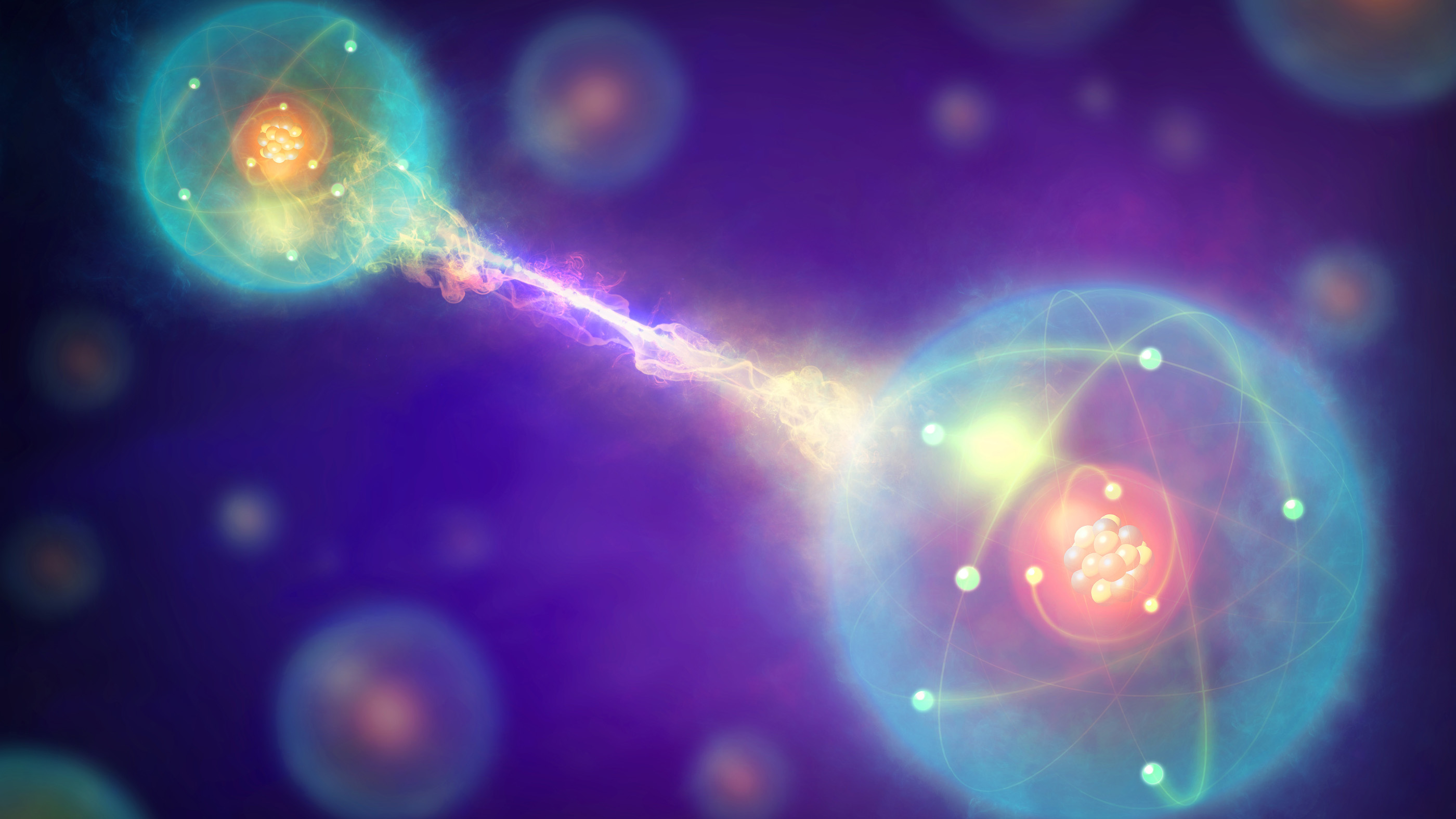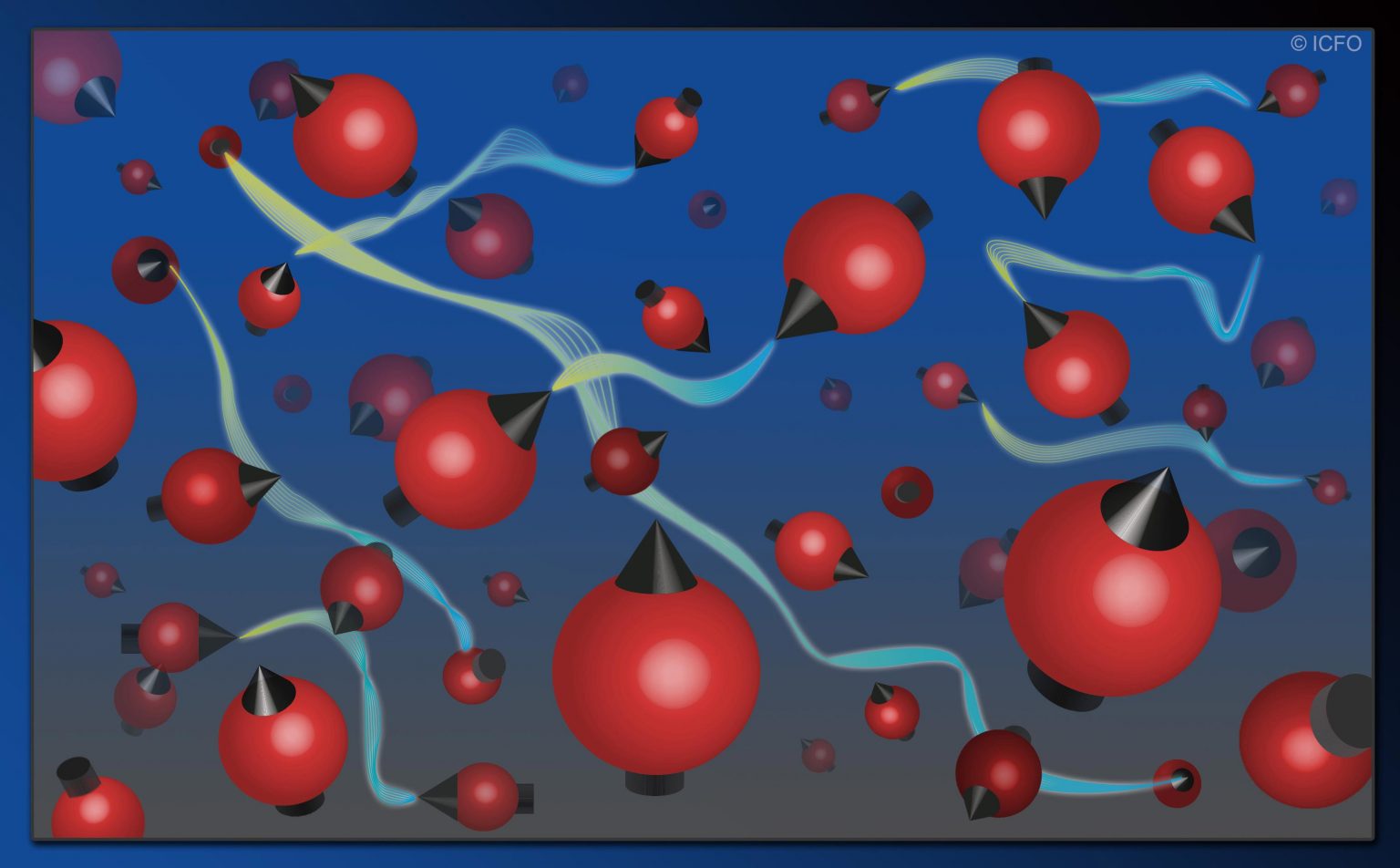What is quantum entanglement?
Quantum entanglement really is "spooky action at a distance."

Quantum entanglement is one of the uber-bizarre phenomena seen when things get itty-bitty, or inside the quantum realm. When two or more particles link up in a certain way, no matter how far apart they are in space, their states remain linked. That means they share a common, unified quantum state. So observations of one of the particles can automatically provide information about the other entangled particles, regardless of the distance between them. And any action to one of these particles will invariably impact the others in the entangled system.
Who discovered quantum entanglement?
Physicists developed the fundamental ideas behind entanglement as they worked out the mechanics of the quantum world in the early decades of the 20th century. They found that to properly describe subatomic systems, they had to use something called a quantum state.
In the quantum world, nothing is ever known for certain; for example, you never know exactly where an electron in an atom is located, only where it might be. A quantum state summarizes the probability of measuring a certain property of a particle, like its position or angular momentum. So, for example, the quantum state of an electron describes all the places you might find it, together with the probabilities of finding the electron at those places.
Another feature of quantum states is that they can be correlated with other quantum states, meaning that measurements of one state can affect the other. In a 1935 paper, Albert Einstein, Boris Podolsky and Nathan Rosen examined how strongly correlated quantum states would interact with each other. They found that when two particles are strongly correlated, they lose their individual quantum states and instead share a single, unified state. Another way to think about it is that a single mathematical "container" can describe all particles simultaneously, regardless of their individual properties. This unified state would become known as quantum entanglement.

They found that if two particles are entangled, meaning their quantum states are strongly correlated and become unified, then measurements of one of the particles automatically influence the other, no matter how far away the particles are from each other, according to the Stanford Encyclopedia of Philosophy.
The first physicist to use the word "entanglement" was Erwin Schrödinger, one of the founders of quantum mechanics. He described entanglement as the most essential aspect of quantum mechanics, saying its existence is a complete departure from classical lines of thought.
What is the EPR paradox?
As Einstein, Podolsky and Rosen discovered, entanglement appears instantaneous: Once you have knowledge of one quantum state, you automatically know the quantum state of any entangled particles. In principle, you could place two entangled particles on opposite ends of the galaxy and still have this instantaneous knowledge, which appears to violate the limit of the speed of light.
Get the world’s most fascinating discoveries delivered straight to your inbox.
This result is known as the EPR paradox (short for Einstein, Podolsky and Rosen), according to the American Physical Society — an effect Einstein dubbed "spooky action at a distance." He used the paradox as evidence that quantum theory was incomplete. But experiments have repeatedly confirmed that entangled particles do influence each other regardless of distance, and quantum mechanics remains verified to this day.
There is no generally accepted resolution to the paradox. However, although entangled systems do not maintain locality (meaning one part of an entangled system can immediately influence a faraway particle), they do respect causality, meaning that effects always have causes. An observer at the faraway particle does not know if the local observer has disturbed the entangled system, and vice versa. They must exchange information with each other no faster than the speed of light to confirm.
In other words, the limits imposed by the speed of light still hold with entangled systems. While you may know the status of a distant particle's state, you cannot communicate this information faster than the speed of light.
How do you create quantum entanglement?
There are many ways to entangle particles. One method is to cool the particles and place them close enough together so that their quantum states (representing the uncertainty in the position) overlap, making it impossible to distinguish one particle from the other.
Another way is to rely on some subatomic process, like nuclear decay, that automatically produces entangled particles. According to NASA, it's also possible to create entangled pairs of photons, or particles of light, by either splitting a single photon and generating a pair of photons in the process, or by mixing pairs of photons in a fiber-optic cable.
What can quantum entanglement be used for?
Perhaps the most widely used application of quantum entanglement is in cryptography. According to Caltech Magazine, in this scenario, a sender and a receiver build a secure communication link that includes pairs of entangled particles. The sender and receiver use the entangled particles to generate private keys, known only to them, that they can use to encode their messages. If someone intercepts the signal and attempts to read the private keys, the entanglement breaks, because measuring an entangled particle changes its state. That means the sender and receiver will know that their communications have been compromised.
Another application of entanglement is quantum computing, in which large numbers of particles are entangled, thereby allowing them to work in concert to solve some large, complex problems. For example, a quantum computer with just 10 qubits (quantum bits) can represent the same amount of memory as 2^10 traditional bits.
What is quantum entanglement teleportation?
Contrary to the usual use of the word "teleport," quantum teleportation does not involve the movement or translation of particles themselves. Instead, in quantum teleportation, information about one quantum state is transported great distances and replicated somewhere else, according to Nature News.
It's best to think of quantum teleportation as the quantum version of traditional communication.
First, a sender prepares a particle to contain the information (i.e., the quantum state) they want to transmit. Then, they combine this quantum state with one of an entangled pair of particles. This causes a corresponding change in the other entangled pair, which can be sitting an arbitrary distance away.
The receiver then records the change in the entangled partner of the pair. Finally, the sender must transmit, via normal channels (i.e., limited by the speed of light), the original change made to the entangled pair. This allows the receiver to reconstruct the quantum state in the new location.
This may seem like a lot of work to pass along one measly piece of information, but quantum teleportation enables completely secure communication. If an eavesdropper intercepts the signal, they will break the entanglement, which would be revealed when the receiver compares the traditional signal to the changes made in the entangled pair.
Learn more:
- MIT has a great explainer on: What is a quantum computer?
- Learn about all the modern uses of quantum entanglement at this University of Waterloo page.

Paul M. Sutter is a research professor in astrophysics at SUNY Stony Brook University and the Flatiron Institute in New York City. He regularly appears on TV and podcasts, including "Ask a Spaceman." He is the author of two books, "Your Place in the Universe" and "How to Die in Space," and is a regular contributor to Space.com, Live Science, and more. Paul received his PhD in Physics from the University of Illinois at Urbana-Champaign in 2011, and spent three years at the Paris Institute of Astrophysics, followed by a research fellowship in Trieste, Italy.



